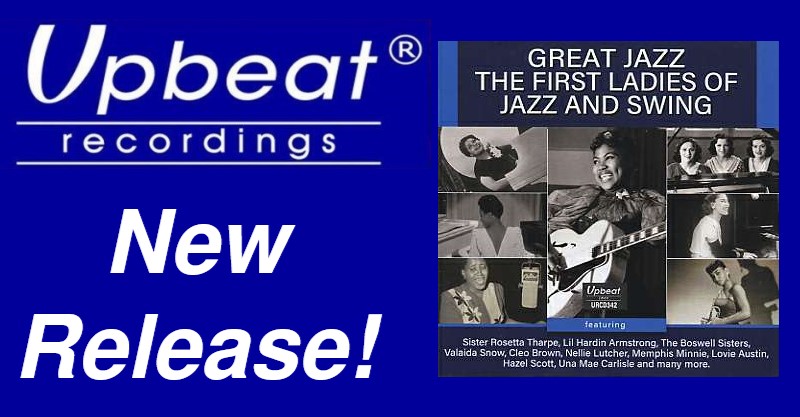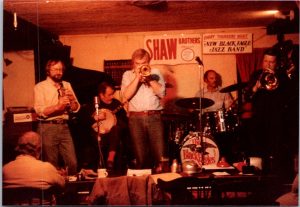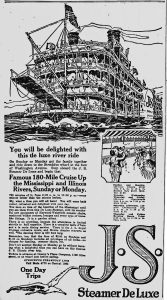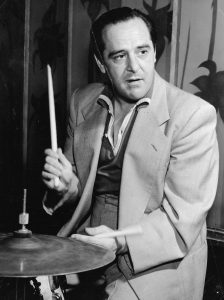 Set forth below is the fifty-second “Texas Shout” column. It first appeared in the July 1994 issue of West Coast Rag, now The Syncopated Times.
Set forth below is the fifty-second “Texas Shout” column. It first appeared in the July 1994 issue of West Coast Rag, now The Syncopated Times.
I can’t remember where I saw it, but I recall reading that there were certain musical themes in common circulation among early ragtime and jazz musicians, ones which no one person seems to have composed, that were considered fair game for anyone in the community to sell to a song publisher and claim on a going-forward basis. That is, nobody got too upset if Musician A sold a composition containing one of these musical notions which, from that time on, was regarded as his.
If I am right in my recollection, I can understand how this situation might have come about. At the turn of the century, Tin Pan Alley was in its infancy. There might not have appeared to be much return to be made out of selling songs for publication, particularly in the Black areas of towns like Sedalia, Missouri, or New Orleans, both of which were not near big sheet music publishing centers. What money there was in ragtime and Dixieland mostly came from gigs.
Anyway, for whatever reason, if you listen to or play Dixieland and ragtime for very long, you will become aware of some of these anthems which turn up from time to time in various pieces, some of them quite well known. There are far too many of them to mention in one column.
However, talking about a few of them might be interesting in itself. Also it might get your ears a little more attuned to do some detective work on your own as you listen in the future.
Let’s get the framework in place before we start. You can find piles of different tunes that have the same chord pattern (Jersey Jazz has just finished running a serialized article listing dozens of similar songs, many of which are new melodies based on standard patterns). For example, there are thousands of variations of the twelve-bar blues.
Other recurring Dixieland chord patterns include those to the choruses to “I Wish I Could Shimmy Like My) Sister Kate,” “How Come You Do Me Like You Do,” “When The Saints Go Marching In” and “Bill Bailey, Won’t You Please Come Home?” Each of these four different chord structures occurs in more jazz tunes than we could begin to discuss here. I’m generally excluding that type of similarity from today’s column.
We’re not talking about cases where, for one reason or another, a tune’s composer recorded it under two different titles, or recorded it under one title and published it under another. Jelly Roll Morton, for example, did those things on several occasions.
Finally, let’s also exclude instances where, consciously or unconsciously, something has been stolen wholesale. The tune entitled “Egyptian Fantasy,” credited to Sidney Bechet, is an illustration thereof. It was actually written by Abe Oleman in 1911 and comprises the first two strains of his pseudo-Eastern instrumental entitled “Egyptia.”
Incidentally, while I don’t condone plagiarism, I can understand what Bechet might have been thinking at the “Egyptian Fantasy” session in 1941. He may well have felt that, as long as nobody remembered “Egyptia” anymore (I don’t think it was a big hit in the first place), why not get a few extra bucks or prestige or whatever by claiming authorship?
In 1941, as now, jazz records usually didn’t sell in huge quantities, so it was unlikely that the royalties on “Egyptian Fantasy” would be worth a lawsuit to claim even if anyone noticed. And if someone told Bechet that over fifty years later, jazz fans all over the world would still be listening to that side, Bechet probably would have wondered what he was smoking.
Now let’s cite a few instances. You won’t be surprised to find that three pioneering names in our music, W.C. Handy, Jelly Roll Morton and the Original Dixieland Jazz Band (hereinafter “ODJB”) are going to pop up with some regularity.
In fact, Handy and Morton intersect on our first example, a tune that must have been floating up and down the Mississippi after the turn of the century. Morton recorded it as “Winin’ Boy Blues” and also used it as a strain of his “Tom Cat Blues.”
Handy, who openly admitted that he got many musical ideas from itinerant musicians passing through Memphis, used the same motive in 1909 as a campaign song for E.H. Crump, who was running for mayor of the city. It was then titled “Mister Crump,” but we now know it as the second strain of Handy’s famous “Memphis Blues.” (Because the first strain is often omitted by today’s Dixieland bands, let’s make clear that we’re talking about the theme that accompanies the lyric “Folks, I’ve just been down, down to Memphis town, …”)
For another use of the “Winin’ Boy/Mister Crump” theme, see “The Camel Walk Blues” by Ebon Gay, published in 1919 by Stark Music. Also relevant, though the “Winin’ Boy” melody is not expressly stated, is the chorus to “Keyhole Blues,” recorded on May 13, 1927 by Louis Armstrong and his Hot Seven.
In 1938 and 1939, Jelly waxed a tune titled “Don’t You Leave Me Here,” the 78 listing “Morton” as the composer. This melody must also have traveled the inland waterways. It appears in two ragtime piano solos published in 1909: “Rag Medley No. II: Strains From Flat Branch,” by Blind Boone, published in Columbia, Missouri, and “I’m Alabama Bound,” by Robert Hoffman, published in New Orleans.
I’m not sure just when Jelly appropriated it. However, if the sleeve of my French LP reissue of the side is to be trusted, “J.R. Morton” was listed as the composer of “Don’t You Leave Me Here” as early as 1927, when it was waxed by Charlie Johnson’s Original Paradise Ten.
Ragtime also supplied another of Jelly’s popular evergreens. “Buddy Bolden’s Blues” is a strain in one of my favorite solos, “St. Louis Tickle,” by Theron C. Bennett, published in 1904 (under the pen name of “Barney & Seymour”).
When Jelly Roll recorded “Georgia Swing” in 1928, the label listed as co-composers “J.R. Morton – S. Pecora.” The latter is trombonist Santo Pecora, who was in the New Orleans Rhythm Kings a few years earlier when the NORK recorded the two strains of “Georgia Swing” as part of a multi-strain piece called “She’s Cryin’ For Me.” However, one of those two strains clearly has its origins in the ODJB’s “Soudan,” recorded in 1920, as well as in the chorus to the well-known Crescent City creole anthem “Eh La Bas.”
While we have Morton and the ODJB on stage together, let’s move on to “Tiger Rag.” Everyone knows that Morton said he created this number by jazzing up strains of an old New Orleans quadrille. It was first recorded in 1918, by the ODJB, with its trumpet player, D.J. LaRocca, getting composer credit.
Morton and the ODJB each put their distinctive spin on “Tiger Rag,” to be sure. However, it has been reported that the tune was commonly played in New Orleans from the earliest days of jazz under titles like “No. 2″ and “Jack Carey.”
In fact, one doesn’t have to be a great musicologist to hear, in the opening portion of “Tiger Rag,” a re-working of the first strain to “Get Out Of Here (And Go On Home),” the closing theme of the first jazzman anyone knows about, cornetist Buddy Bolden. It shows up again, in slightly altered form, as the B theme to King Oliver’s “Chattanooga Stomp.”
For that matter, the first strain of “Chattanooga Stomp” clearly derives from the first strain to the ODJB’s “Fidgety Feet.” And while we’re on Oliver, let’s mention that the first strain to “Mabel’s Dream” (a tune recorded by Oliver but credited to Ike Smith) is the same as the first strain to the ODJB’s earlier “Lazy Daddy.”
Before we leave Handy, Morton and the ODJB, let’s pause for Handy’s 1915 work “The Hesitating Blues.” The itinerant musician who passed through Memphis with this tune must have circled through Louisville as well, because its main motive makes up the refrain to “Hesitation Blues,” published that same year in Louisville, with Scott Middleton and Billy Smythe listed as co-composers.
In 1921, Handy published “Loveless Love,” which uses the familiar “Careless Love” as its chorus, preceded by a verse structured in 12-bar blues form. I’d guess that it is this publication which causes many uptown New Orleans-style bands to open their renditions of “Careless Love” with a couple of run-throughs of the twelve-bar blues, though not usually following Handy’s or any other commonly accepted melody.
Similarly, in 1914, a number titled “The Long Lost Blues” appeared with lyrics credited to H. Alf Kelly and music to J. Paul Wyler. Its chorus is the old standby “Bucket’s Got A Hole In It.” Years later, on George Lewis’ version of “Bucket’s …,” the band plays a verse that turns out to be the verse from the sheet music on “The Long Lost Blues!” Now, just as with “Careless Love,” when uptown-style New Orleans Dixielanders play that verse on “Bucket’s …,” whether they know it or not, they’re really (in one sense, at least) playing “The Long Lost Blues” instead.
In 1926, pianist Lillian Armstrong was credited as composer of the eight tunes recorded by a wonderful band known by two names, the New Orleans Wanderers and the New Orleans Bootblacks. One of those was a straight-ahead two-themed swinger called “Gate Mouth.”
For the chorus of “Gate Mouth,” Lil drew on a notion that seems to be everywhere among Dixielanders. It was published in 1917 as the chorus to “Mama’s Baby Boy,” listing John A. St. Cyr and Armand J. Piron as co-composers. The Wanderers/Bootblacks trombonist, the great Kid Ory, carried it into the revival period as “Do What Ory Say.” Lu Watters’ Yerba Buena Jazz Band waxed it as “Get It Right.” The mid-1970s version by Don Kinch’s Conductors’ Ragtime Band comes on under the whimsical title “Taiwan Ahn.”
Let me emphasize that these various examples need not be plagiarism, but probably represent musicians drawing on more or less common property and giving it their own individualistic interpretations, something that is a specialty of the best Dixielanders. “Winin’ Boy Blues” and the second strain to “Memphis Blues” really have a quite different feeling, even though they come from the same source and differ significantly in only one spot (where Jelly uses a minor chord while Handy uses a major). Similarly, “Buddy Bolden’s Blues,” at its typical slow pace, paints a much different musical picture than Theron C. Bennett’s ragtime version.
Besides, as I said, nobody got too bent out of shape about these ideas being borrowed. Well, almost nobody. It has been reported that Louis Armstrong claimed to have written “(I Wish I Could Shimmy Like My) Sister Kate,” and was so annoyed at A.J. Piron’s name appearing on the song sheet as sole composer that Satchmo would never perform the selection!
You may think that this kind of analysis is musical navel-gazing. However, I find it interesting to try to dig out the origins of some of these tunes we like so much, and to notice how several of them pop up here and there in different costumes.
There are lots more examples, but the foregoing will do for now. I’ve showed you how to play the game, and you can have some fun finding your own recurring themes. Besides, I want to end this column with the most bizarre example I’ve yet encountered of unconscious tune- borrowing.
Most of you have heard, at festivals or on record, a number entitled “Red Flannel Rag.” It’s a three-strain piece, with an introduction and a strangely- harmonized interlude, that is credited to Turk Murphy. Once past the four-bar introduction, “Red Flannel Rag” is identical in all significant respects to “Lazy Luke,” a ragtime piano solo composed by George J. Philpot, published in Boston in 1904, a decade before Turk was born.
At a St. Louis festival in the late 1970s, I had a chance to ask Turk about it. He told me that he’d never heard of “Lazy Luke” or George J. Philpot, and asked me to send him a copy of the music, which I promptly did. When we next met, Turk agreed that the tunes were identical.
He was at a loss to explain it. Turk felt sure that he had written “Red Flannel Rag.”
Personally, I have no reason to doubt Turk’s sincerity. First, his reputation in all quarters was that of a square-shooter. Second, his stature as a composer of quality Dixieland tunes was so secure that there was no reason for him to steal an old ragtime composition.
My guess is that, when Turk was a kid, someone in his neighborhood liked to play “Lazy Luke,” or had a record or piano roll of it, so that Turk became exposed to the tune subliminally. Decades later, it emerged as an “original” composition.
Stranger things have happened. I’ve heard it said that everything you’ve been exposed to is still rattling around in your brain somewhere, waiting for you to discover how to get access to it.
Maybe we’re lucky we can’t do so. Can you imagine having to relive your memories of the ten worst bands you ever heard? On that note, let’s call it a day.
 Want to read ahead? Buy the book!
Want to read ahead? Buy the book!
The full run of “Texas Shout” has been collected into a lavishly illustrated trade paperback entitled Texas Shout: How Dixieland Jazz Works. This book is available @ $20.00 plus $2.95 shipping from Tex Wyndham, On request, Tex will autograph the book and add a personalized note (be sure to tell him to whom the note should be addressed).
Tex Wyndham’s 3 CD Guide to Dixieland with music and commentary is available for $20 plus $2.95 shipping. The separate CD, A History of Ragtime: Tex Wyndham Live At Santa Rosa, is available for $13.00 plus $2.00 shipping. On request, Tex will autograph the inner sleeve and add a personalized note (be sure to tell him to whom the note should be addressed).
Send payment to Tex Wyndham, P.O. Box 831, Mendenhall, PA 19357, Phone (610) 388-6330.
Note: All links, pictures, videos or graphics accompanying the Shouts were added at the discretion of the Syncopated Times editorial staff. They did not accompany the original columns and do not necessarily reflect the opinion of Tex Wyndham.
From roughly 1970-2010, Tex Wyndham was: (1) one of the best-known revivalist Dixieland jazz musicians in the US, as cornetist, pianist and bandleader, (2) one of the best-known ragtime pianists in the US, and (3) one of the most respected critics in the US of Dixieland jazz, ragtime, and related music. He is the only person about whom all three of those statements can be made.



















